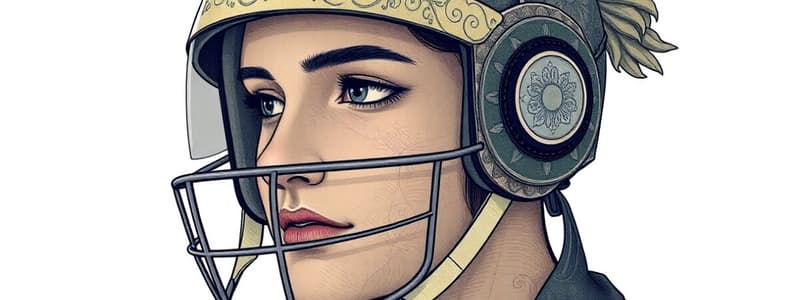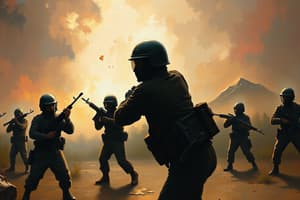Podcast
Questions and Answers
Which design feature is LEAST important for a face guard to effectively minimize facial injuries in sports like hockey or lacrosse?
Which design feature is LEAST important for a face guard to effectively minimize facial injuries in sports like hockey or lacrosse?
- A construction that offers a variety of protective options depending on the sport and the player's position.
- The inclusion of additional attachments to enhance protection in high-impact zones. (correct)
- Flush mountings to the helmet to prevent snagging or secondary impacts.
- An opening size that prevents the passage of sticks or pucks, offering comprehensive coverage.
Following the increase in serious neck injuries in sports, what is the MOST critical factor to consider when evaluating the effectiveness of a neck guard?
Following the increase in serious neck injuries in sports, what is the MOST critical factor to consider when evaluating the effectiveness of a neck guard?
- The aesthetic design and color coordination of the neck guard with the sports uniform.
- The material's ability to resist cuts and blunt force while not impeding range of motion. (correct)
- The extent to which the neck guard allows for unrestricted head and neck movement during gameplay.
- The ease with which the neck guard can be removed by medical personnel in emergency situations.
What is the PRIMARY purpose of a mouth guard in sports, beyond preventing direct dental trauma?
What is the PRIMARY purpose of a mouth guard in sports, beyond preventing direct dental trauma?
- To minimize the risk of lip lacerations and absorb chin blow impacts, potentially reducing concussion risk. (correct)
- To enhance the athlete's ability to communicate clearly with teammates during play.
- To provide a psychological advantage by projecting an image of toughness to opponents.
- To improve airflow and reduce the sensation of claustrophobia for athletes in high-intensity situations.
An athlete complains that their mouth guard feels too bulky and impedes their breathing. What modification would MOST directly address this issue while maintaining its protective qualities?
An athlete complains that their mouth guard feels too bulky and impedes their breathing. What modification would MOST directly address this issue while maintaining its protective qualities?
In sports, eye injuries are MOST commonly the result of what type of trauma?
In sports, eye injuries are MOST commonly the result of what type of trauma?
What is the MOST significant challenge athletes face when using standard eye glasses for eye protection during sports, leading to a need for sport-specific eyewear?
What is the MOST significant challenge athletes face when using standard eye glasses for eye protection during sports, leading to a need for sport-specific eyewear?
A hockey player is debating between a full cage and a half visor. Considering the trade-offs, what is the MOST accurate assessment of the differences in protection?
A hockey player is debating between a full cage and a half visor. Considering the trade-offs, what is the MOST accurate assessment of the differences in protection?
Given the evolving nature of research on mouth guards and concussion prevention, what is the MOST effective strategy for coaches and athletic trainers to ensure they are providing athletes with the best advice?
Given the evolving nature of research on mouth guards and concussion prevention, what is the MOST effective strategy for coaches and athletic trainers to ensure they are providing athletes with the best advice?
Flashcards
Face Guards
Face Guards
Protective equipment that covers the face to reduce injuries during sports.
Mouth Guards
Mouth Guards
Devices worn in the mouth to prevent dental injuries and minimize concussions.
Types of Mouth Guards
Types of Mouth Guards
There are three types: stock, commercial, and custom mouth guards.
Ear Protection
Ear Protection
Signup and view all the flashcards
Eye Protection
Eye Protection
Signup and view all the flashcards
Neck Guards
Neck Guards
Signup and view all the flashcards
Face Trauma
Face Trauma
Signup and view all the flashcards
Hockey Cages
Hockey Cages
Signup and view all the flashcards
Study Notes
Face Protection
- Five categories of face protection: face guards, throat protection, mouth guards, ear protection, and eye protection.
- Face guards have reduced the number of facial injuries.
- A variety of protective options exist, depending on the sport and player's position.
- No additional attachments are allowed.
- All mountings must be flush with the helmet.
- The opening cannot allow sticks or pucks to pass through.
Shatter Proof Face Guard
- Protects the face from injuries in sports like basketball, softball, baseball, soccer, and others where facial injuries can occur.
- The guards are virtually indestructible.
- They offer a comfortable fit.
- Energy displacement technology is used.
Hockey Cages
- Hockey cages are a form of face protection.
- Visors, specifically half-visors versus goalie skates, are discussed.
Face Trauma
- X-check to the face can cause facial trauma.
Neck Guards
- The purpose of neck guards is discussed as well as a YouTube link to an injury graphic.
- Injuries from Richard Zednik, Clint Malarchuk, and Jessica Dube are mentioned.
Mouth Guards
- Mouth guards prevent dental injuries.
- They help prevent concussions.
- They protect teeth, minimize lip lacerations, and absorb shock from chin blows.
- Comfortable fit that extends as far back as the last molar.
- Built from flexible and resilient material.
- Constructed to fit teeth and upper jaw without impeding breathing.
Mouth Guard Usage
- The purpose and complaints regarding mouth guards are mentioned.
- Links to studies on mouth guards and concussion are mentioned.
Mouth Guards Types
- Three types of mouth guards exist: stock, commercial, and custom.
Ear Protection
- Sports that might utilize ear guards are listed.
- The purpose of ear protection is explored.
Eye Protection
- Most eye sports injuries are blunt trauma.
- The majority of sports-related eye injuries are caused by trauma.
- Eye protection is vital, especially in sports involving projectiles.
- Eye guards grant significant protection, however, they can sometimes limit vision.
- The NHL mandates half-visors to enhance eye protection.
Contact Lenses
- Advantages and disadvantages of wearing contact lenses are mentioned.
- Nike MaxSight contact lenses are discussed with their features and discontinuation reasons.
Studying That Suits You
Use AI to generate personalized quizzes and flashcards to suit your learning preferences.




